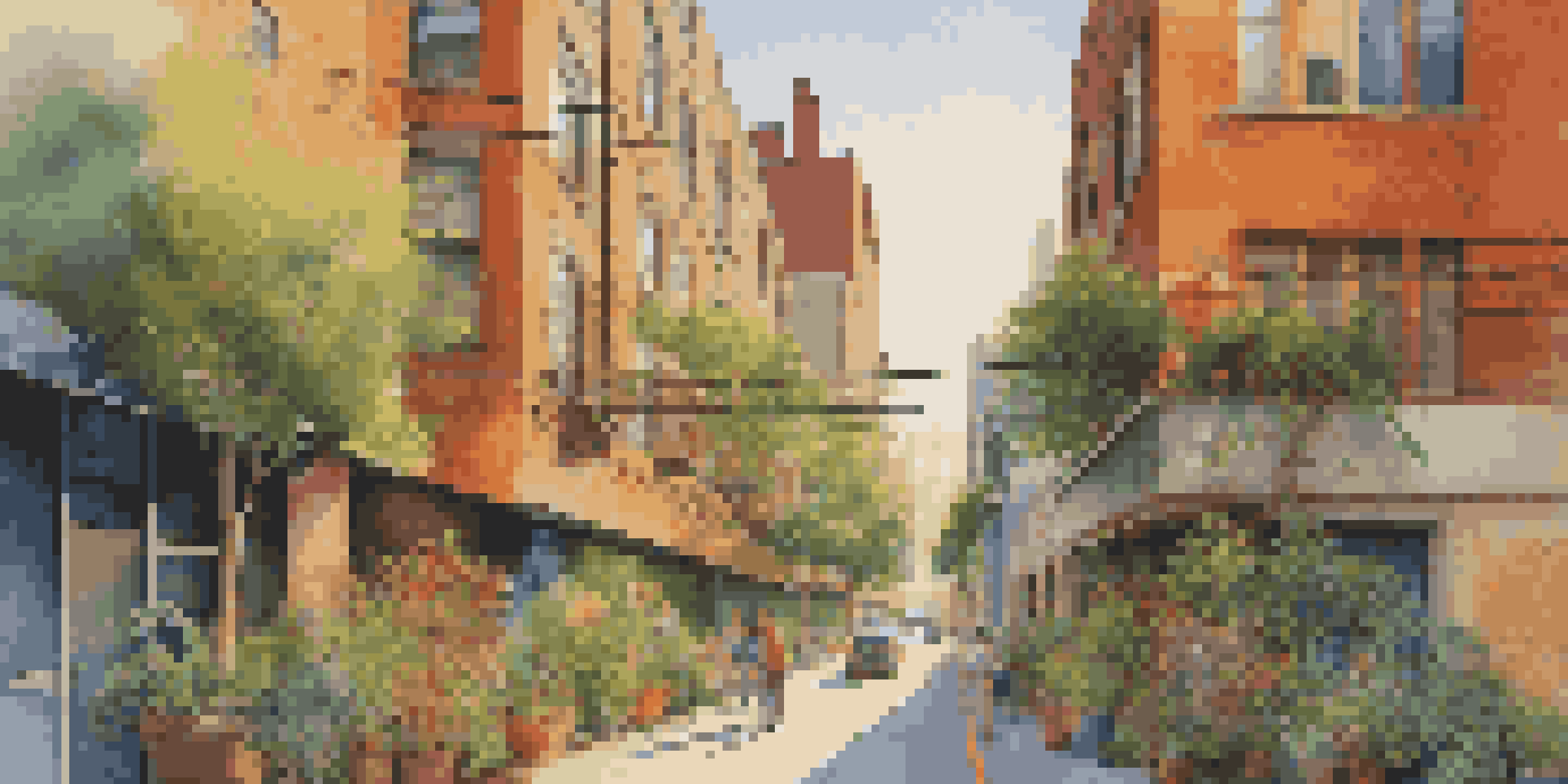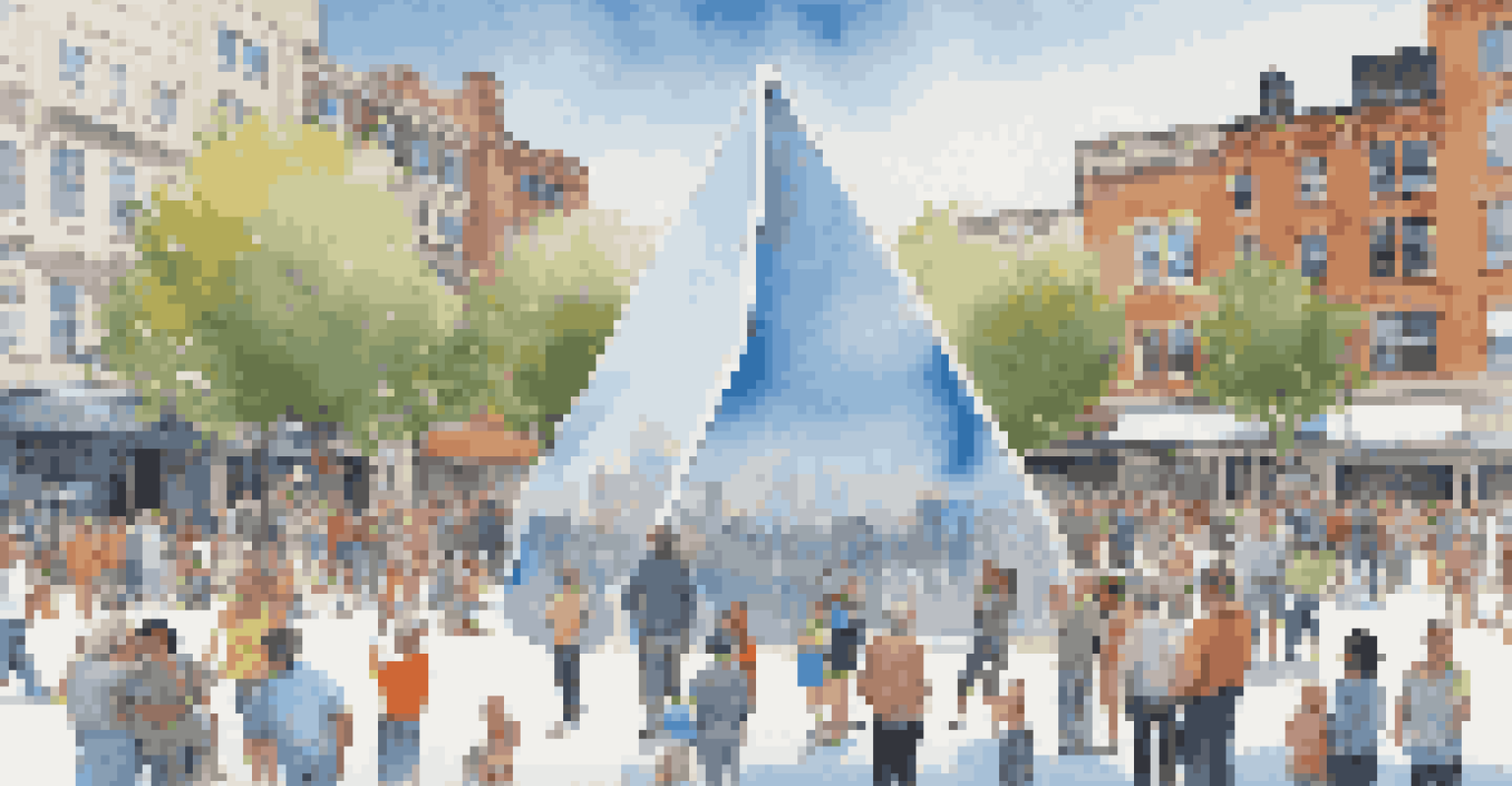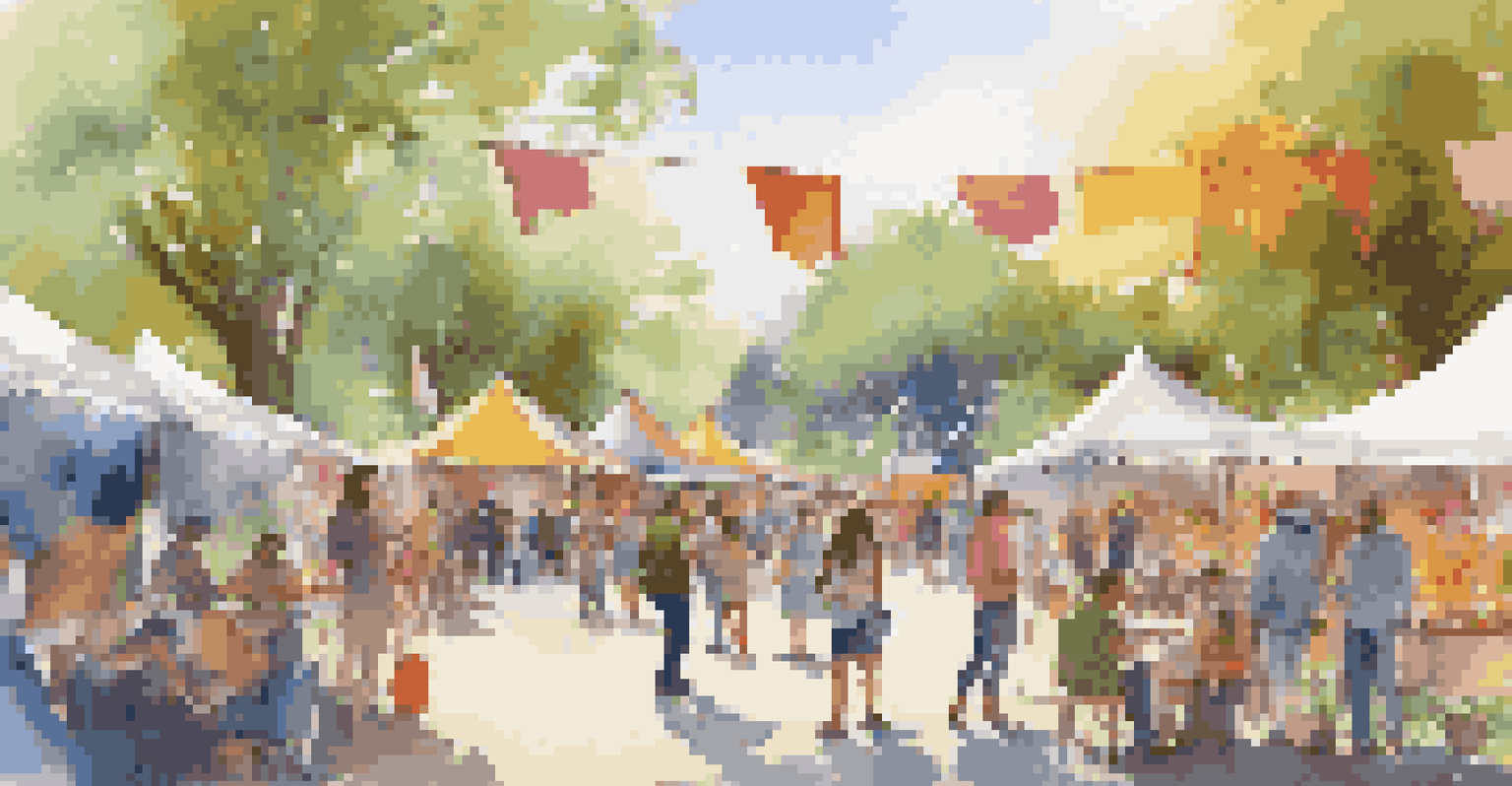Art and the Urban Experience: Capturing City Life and Humanity

The Intersection of Art and Urban Life
Art has always been a mirror reflecting the society around it, and urban areas are no exception. In bustling cities, art captures the vibrancy and diversity of human experiences, telling stories that echo through the streets. These artistic expressions can be found everywhere, from street murals to performance art in public parks, illustrating the pulse of city life.
Art is the most beautiful of all lies.
By examining how art interacts with the urban environment, we see not just creativity but also commentary on social issues, culture, and community. For instance, a vibrant mural can transform a dull alleyway into a space of inspiration and dialogue. This interaction fosters a sense of belonging, encouraging locals and visitors alike to engage with their surroundings.
Moreover, art in urban settings invites us to reflect on our shared humanity. It connects people from different backgrounds and encourages them to appreciate the unique tapestry of life that exists within the city. This connection is vital in fostering a sense of unity amidst the hustle and bustle.
Street Art: Voices of the Urban Community
Street art, often viewed as a form of rebellion, serves as a powerful voice for the urban community. Artists utilize walls as canvases to express their opinions on societal issues, from inequality to environmental concerns. This art form transforms public spaces into platforms for commentary and change, inviting viewers to engage in critical conversations.

Take, for example, the works of Banksy, whose thought-provoking pieces challenge the status quo and provoke thought. His art often highlights the plight of marginalized communities, prompting viewers to reconsider their perceptions of urban life. Such impactful works remind us that art can inspire action and foster awareness.
Art Reflects Urban Diversity
Art in urban areas captures and celebrates the vibrant stories and diverse experiences of city life.
In essence, street art democratizes creativity, allowing anyone to contribute to the narrative of their city. With each piece, artists weave their experiences and observations into the fabric of urban life, creating a dialogue that resonates with both residents and visitors.
The Role of Public Installations in City Spaces
Public art installations play a crucial role in shaping the urban landscape, offering engaging experiences for all who encounter them. These pieces, whether sculptures, interactive displays, or temporary installations, invite curiosity and interaction. They not only beautify public spaces but also encourage people to stop, reflect, and engage with their environment.
The city is not a concrete jungle, it is a human zoo.
Consider the famous 'The Bean' in Chicago, a large, reflective sculpture that draws people in, reflecting the city skyline and its visitors. Such installations create moments of joy and wonder, fostering a sense of connection among those who gather around them. They become landmarks and conversation starters, enriching the urban experience.
Moreover, public art can play a significant role in community identity. By reflecting local culture and history, these installations help residents feel rooted in their surroundings, enhancing their sense of belonging. In this way, art not only decorates but also defines urban spaces.
Art Festivals: Celebrating Urban Creativity
Art festivals have become vibrant celebrations of creativity in urban environments, bringing together artists, performers, and audiences from diverse backgrounds. These events showcase a wide range of artistic expressions, from visual art to live performances, creating a festive atmosphere that invigorates city life. They provide a platform for emerging talent while also honoring established artists.
Take, for instance, the annual Artscape festival in Baltimore, which transforms the city into a hub of creativity and expression. With live music, art installations, and workshops, attendees immerse themselves in the artistic process, fostering a deeper appreciation for the arts. Such festivals highlight the importance of community engagement in the cultural landscape.
Street Art as Social Commentary
Street art serves as a powerful voice for communities, addressing social issues and fostering dialogue.
Additionally, art festivals often spark economic growth by attracting visitors to local businesses and promoting tourism. They serve as a reminder of the vital role art plays in not only enriching our lives but also supporting local economies. In this way, festivals become a catalyst for both creativity and community development.
Photography: Capturing Fleeting Moments of Urban Life
Photography offers a unique lens through which we can explore and capture the essence of urban life. Photographers have the ability to freeze moments in time, showcasing the beauty and complexity of city living. Whether it's the hustle of commuters or the quiet moments in a park, photography tells stories that resonate with many.
Consider the iconic work of Henri Cartier-Bresson, who famously coined the term 'the decisive moment.' His images encapsulate the spontaneity and vibrancy of urban life, drawing viewers into the scene. Through his lens, we gain insight into the human experience, making us reflect on our own lives within the city.
Moreover, photography can serve as a powerful tool for social change. Documenting issues such as poverty, gentrification, and community resilience, photographers bring attention to stories that may otherwise go unnoticed. In doing so, they inspire empathy and understanding, encouraging viewers to engage with the world around them.
Art and Gentrification: A Double-Edged Sword
While art can breathe new life into urban areas, it can also contribute to gentrification, raising complex questions about its impact on communities. As artists move into neighborhoods, they often attract attention and investment, leading to increased property values. This process can displace long-term residents, altering the very fabric of the community.
Take the example of Williamsburg in Brooklyn, where once-gritty industrial spaces became art hubs, only to see local artists pushed out as rents soared. This phenomenon illustrates the delicate balance between celebrating art and protecting community integrity. It's essential to consider who benefits from artistic revitalization and at what cost.
Art Festivals Boost Community Spirit
Art festivals not only showcase creativity but also promote local engagement and economic growth.
Ultimately, fostering a dialogue about art's role in gentrification is crucial for creating inclusive urban spaces. Communities must engage in discussions about how to support artists while preserving the character and diversity of neighborhoods. By prioritizing equitable practices, we can celebrate art without sacrificing the communities it seeks to uplift.
The Future of Art in Urban Settings
As cities continue to evolve, so too will the role of art in shaping urban experiences. With the rise of technology and digital art forms, we are witnessing a transformation in how art interacts with the urban landscape. Augmented reality installations and interactive digital displays are just a few examples of how technology is enhancing artistic expression.
Moreover, the growing focus on sustainability is influencing artists to create works that reflect ecological concerns. From eco-friendly murals to installations made from recycled materials, artists are using their platforms to advocate for environmental change. This fusion of art and sustainability presents exciting opportunities for reimagining urban spaces.

In conclusion, the future of art in urban settings holds immense potential for fostering connection, creativity, and community. As artists continue to explore new mediums and engage with pressing social issues, they will undoubtedly shape the narrative of city life. The relationship between art and the urban experience will remain dynamic, reflecting the ever-changing tapestry of humanity.